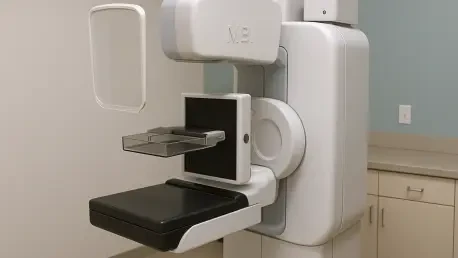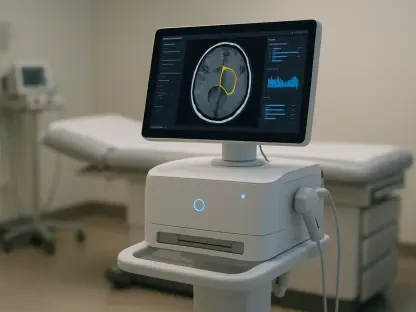In the complex landscape of breast cancer screening, a significant hurdle persists for women with dense breasts, where the composition of their tissue often masks potential malignancies on traditional mammograms, heightening the risk of late-stage diagnoses. A pioneering study published in Radiology, under the title “Molecular Breast Imaging and Digital Breast Tomosynthesis for Dense Breast Screening: The Density MATTERS Trial,” brings a ray of hope to this challenge. Spearheaded by Dr. Carrie B. Hruska at Mayo Clinic, the research delves into the effectiveness of combining Molecular Breast Imaging (MBI) with Digital Breast Tomosynthesis (DBT), a sophisticated 3D mammography technique. This innovative pairing aims to enhance cancer detection for a population that constitutes nearly half of those screened, addressing a critical gap in early diagnosis and offering the potential to save lives through timely intervention.
Dense breast tissue, characterized by a higher proportion of fibrous and glandular components compared to fatty tissue, poses a unique obstacle in imaging, often rendering standard mammography less effective. The Density MATTERS Trial, a multicenter effort, recruited nearly 3,000 asymptomatic women aged 40 to 75 with dense breasts to evaluate whether MBI, which utilizes a radiotracer to detect metabolic activity in breast tissue, could complement DBT in overcoming these limitations. Conducted across diverse clinical settings, the study’s findings reveal a substantial improvement in identifying invasive cancers that might otherwise remain hidden, marking a significant step forward in tailored screening approaches for this high-risk group.
The Power of Combined Screening
Enhancing Early Detection
The impact of integrating MBI with DBT in breast cancer screening is profound, particularly in its ability to uncover cancers at their earliest and most treatable stages. During two comprehensive screening rounds in the Density MATTERS Trial, MBI detected 30 breast cancer lesions across 29 participants that DBT alone failed to identify. Strikingly, over 70% of these were invasive cancers, with a median size of just 0.9 cm, indicating detection well before significant progression. Most of these cases showed no lymph node involvement, a critical factor in improving prognosis and treatment outcomes. This capability to catch cancers early underscores the potential of MBI as a vital tool in reducing the burden of advanced diagnoses among women with dense breasts, paving the way for more effective intervention strategies.
Another key revelation from the trial centers on the detection of node-positive cancers, which signal more advanced disease due to spread to the lymph nodes. In the initial screening year, the combination of MBI and DBT identified 100% of node-positive cases among participants, a stark contrast to the 57% detected by DBT alone. Even in the subsequent year, the combined approach outperformed standalone DBT, though a small fraction of cases eluded both methods. This complementary strength of MBI highlights its role in capturing critical cancers that could progress if missed, offering a more robust defense against late-stage discoveries. Such findings emphasize the importance of adopting multi-modal screening for women whose dense breast tissue obscures traditional imaging results.
Targeting Advanced Disease
Focusing on the specifics of advanced cancer detection, the trial data reveals how MBI enhances the identification of aggressive malignancies that DBT might overlook. Among the cancers detected solely by MBI, a significant portion included invasive types with potential for rapid progression, yet caught at a stage where intervention could be most effective. The ability to pinpoint these hidden threats, especially in a population already at elevated risk due to breast density, suggests a shift toward more personalized screening protocols. By addressing cancers that are mammographically occult, MBI provides a safety net, ensuring that women undergoing routine checks are less likely to face a delayed diagnosis of severe disease, which often carries a graver prognosis.
Moreover, the trial’s emphasis on node-positive detection rates illustrates a critical advantage in combining technologies for comprehensive care. While DBT offers improved visualization over traditional 2D mammography, its limitations in dense tissue are evident when compared to the combined approach, which significantly boosted the detection of cancers with lymph node involvement. This improvement is not just a statistic but a potential lifeline for patients, as identifying node-positive disease early can alter treatment pathways, often leading to less invasive procedures and better survival rates. The consistent incremental benefit of MBI across screening rounds further solidifies its value as an adjunctive tool in modern breast imaging practices.
Practical Benefits and Challenges
Balancing Detection and Recalls
While the enhanced cancer detection rates achieved by pairing MBI with DBT represent a major advancement, this approach does introduce a modest uptick in recall rates, where additional follow-up testing is required. The Density MATTERS Trial notes that this increase, though not quantified in exact figures, remains within a manageable range, ensuring that the benefits of identifying more cancers are not overshadowed by excessive patient callbacks. Striking this balance is essential for the broader adoption of MBI in clinical settings, as it mitigates the risk of overwhelming healthcare resources or causing unnecessary anxiety among patients. The focus remains on optimizing protocols to maximize detection while minimizing the burden of additional procedures, a crucial consideration for integrating new technologies into routine practice.
Another aspect to consider is the impact of increased recalls on patient experience and healthcare systems, which must be carefully managed to maintain trust and efficiency. Although follow-up tests can be stressful, the trial suggests that the improved detection of potentially life-threatening cancers justifies this trade-off, provided that communication with patients is clear and supportive. Healthcare providers must weigh the psychological and logistical implications of recalls against the undeniable advantage of catching malignancies early. As MBI gains traction, refining criteria for follow-up could further reduce unnecessary procedures, ensuring that the focus remains on those most likely to benefit from additional scrutiny, thus enhancing the overall effectiveness of screening programs.
Advantages of MBI in Practice
On the practical front, MBI emerges as a highly feasible option for supplemental screening, offering distinct advantages over other modalities like MRI. Its use of a radiotracer, akin to those employed in cardiac imaging, ensures a low-risk profile with minimal chance of adverse reactions, unlike contrast-based methods. Additionally, MBI is described as well-tolerated by patients and more cost-effective, making it a viable choice for widespread implementation across diverse healthcare environments. Dr. Hruska underscores the importance of educating patients about the array of screening options available, empowering them to engage in shared decision-making with their providers to determine the most suitable approach for their individual risk profiles and preferences.
Beyond safety and affordability, the adaptability of MBI to various clinical settings further bolsters its appeal as a screening tool. The trial’s inclusion of both academic medical centers and community hospitals demonstrates that MBI can be effectively deployed regardless of resource levels, broadening access for women with dense breasts who might otherwise lack advanced imaging options. This scalability is vital for addressing disparities in healthcare delivery, ensuring that cutting-edge detection methods reach a wider population. By fostering informed choices and providing a practical solution, MBI stands to reshape how supplemental screening is approached, prioritizing both clinical outcomes and patient-centered care in the fight against breast cancer.
Looking Ahead to Refined Strategies
Reflecting on the strides made, the Density MATTERS Trial laid a strong foundation for enhancing breast cancer screening through the integration of MBI with DBT, particularly for women with dense breasts where traditional methods often fall short. The evidence gathered showed a marked improvement in detecting invasive cancers, including those with node-positive status, which had previously gone unnoticed by standard imaging alone. This success in identifying critical cases early had a tangible impact on reducing the likelihood of advanced-stage diagnoses, a persistent concern in this high-risk group. The trial’s insights, drawn from a diverse cohort across multiple clinical environments, cemented the relevance of MBI as a complementary tool, balancing heightened detection with practical considerations like safety and cost.
As a forward-looking step, the findings underscored the need for continued refinement in screening protocols to optimize outcomes further. Healthcare providers were encouraged to focus on tailoring approaches to individual risk factors, ensuring that tools like MBI are used strategically to maximize benefits while addressing the modest rise in recall rates. Policymakers and clinicians alike could build on this research by exploring ways to integrate MBI seamlessly into existing frameworks, potentially reducing disparities in access to advanced diagnostics. Emphasizing patient education also emerged as a priority, empowering women to make informed decisions about their screening paths. Ultimately, the trial’s legacy pointed toward a future where personalized, multi-modal strategies could transform early detection, offering a clearer path to improved survival rates and better quality of life for countless patients.









